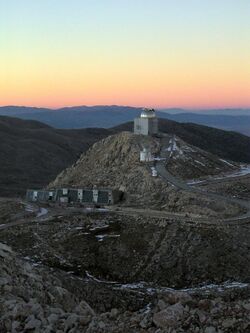Astronomy:TÜBİTAK National Observatory
 TÜBİTAK National Observatory at Bakırtepe, Antalya Province, Turkey | |||||||||||
| Organization | Scientific and Technological Research Council of Turkey | ||||||||||
|---|---|---|---|---|---|---|---|---|---|---|---|
| Location | Bakırtepe, Antalya, Turkey | ||||||||||
| Coordinates | [ ⚑ ] : 36°49′27″N 30°20′8″E / 36.82417°N 30.33556°E | ||||||||||
| Altitude | 2,450 m (8,040 ft) | ||||||||||
| Website | www | ||||||||||
| Telescopes | |||||||||||
| |||||||||||
TÜBİTAK National Observatory (Turkish: TÜBİTAK Ulusal Gozlemevi, TUG) is a ground-based astronomical observatory operated by the TUG Institute of the Scientific and Technological Research Council of Turkey (TUBITAK). Established in 1991, it is located at an altitude of 2,450 m (8,040 ft) in Bakırtepe, around 50 km (31 mi) west-southwest of Antalya in southern Turkey.
There are five telescopes installed in Bakırtepe:
- RTT150 - Russian-Turkish 1.5-m Telescope (formerly AZT-22) (2001)[1][2]
- T100 (ACE RC1.0) - 1.0 m Ritchey–Chrétien telescope (2009)[3]
- T60 (OMI RC06) - 0.6 m Ritchey–Chrétien telescope (2008)[4]
- YT40 (Meade LX200GPS) - 0.4 m Schmidt–Cassegrain telescope (2006)[5][6]
- ROTSEIIID Robotic Optical Transient Search Experiment[7]
Discoveries
Scientists led by a Turkish astronomer from Ankara University discovered an exoplanet orbiting the giant star HD 208897, which is located at a distance of some 210 light years from the Earth.[8] The exoplanet has a minimum mass of 1.4 Jupiter masses, and rotates its parent star from about 1.05 AU (156,000,000 km (97,000,000 mi)) away in every 353 days on a nearly circular orbit. The discovery is the result of a ten-year-long research work of precise radial-velocity method carried out by using the Coude Echelle Spectrograph (CES) installed on the 1.5-meter Russian-Turkish Telescope (RTT150). Follow-up observations at the Okayama Astrophysical Observatory (OAO) in Japan and the Ankara University Kreiken Observatory (AUKR) confirmed the discovery, which was made public on August 6, 2017.[9]
References
- ↑ "RTT150 Teleskobu" (in Turkish). TUG-TÜBİTAK. http://www.tug.tubitak.gov.tr/rtt150_ozellikler.php. Retrieved 2013-02-18.
- ↑ "RTT150 Russian-Turkish 1.5-m Telescope". Head Iki. http://hea.iki.rssi.ru/AZT22/ENG/index.html. Retrieved 2013-02-18.
- ↑ "T100 Teleskobu" (in Turkish). TUG-TÜBİTAK. http://www.tug.tubitak.gov.tr/t100_ozellikler.php. Retrieved 2013-02-18.
- ↑ "T60 Teleskobu" (in Turkish). TUG-TÜBİTAK. http://www.tug.tubitak.gov.tr/t60_ozellikler.php. Retrieved 2013-02-18.
- ↑ "YT40 Teleskobu (2006-2008)" (in Turkish). TUG-TÜBİTAK. http://www.tug.tubitak.gov.tr/yt40_ozellikler.php. Retrieved 2013-02-18.
- ↑ "LX200 Series". Meade Instruments. http://meade.com/lx200.
- ↑ "ROTSEIIID Teleskobu" (in Turkish). TUG-TÜBİTAK. http://www.tug.tubitak.gov.tr/rotseiiid.php. Retrieved 2013-02-18.
- ↑ "Turkish scientists discover a planet for the first time". Daily Sabah. 2017-08-13. https://www.dailysabah.com/turkey/2017/08/14/turkish-scientists-discover-a-planet-for-the-first-time. Retrieved 2017-08-21.
- ↑ Nowakowski, Tomasz report (2017-08-10). "Jupiter-mass planet orbiting giant star discovered". PHYS ORG. https://phys.org/news/2017-08-jupiter-mass-planet-orbiting-giant-star.html. Retrieved 2017-08-21.
 |

